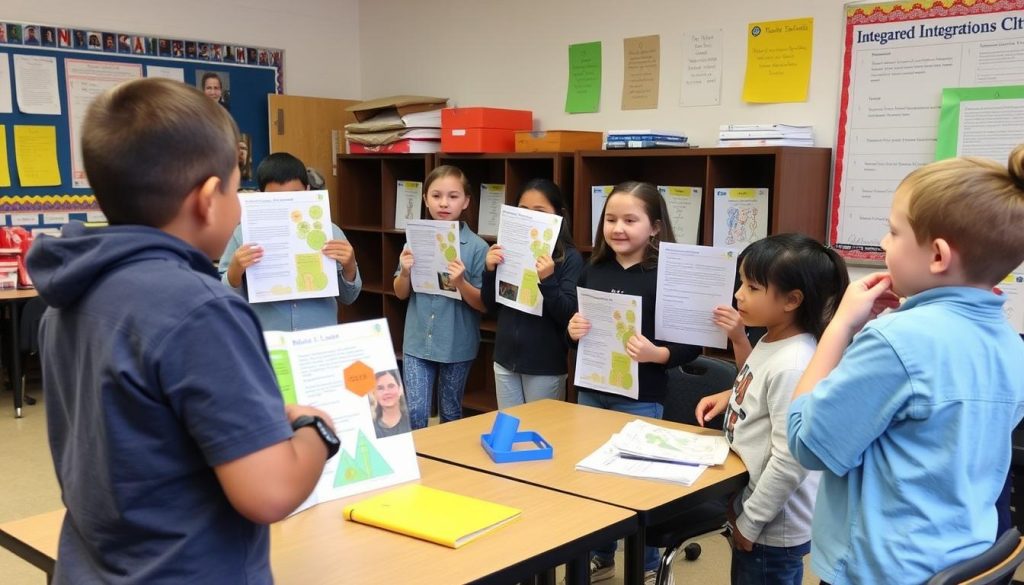Integrating standards creates meaningful learning experiences that connect multiple subject areas
Why Integrating Standards Matters in Modern Education
The traditional approach of teaching standards in isolation often leads to fragmented learning and time management challenges. When we examine how integrating standards transforms the classroom experience, several key benefits emerge for both teachers and students.
Benefits for Students
- Deeper conceptual understanding through meaningful connections
- Improved retention through multiple exposures to key concepts
- Enhanced engagement with relevant, real-world applications
- Development of critical thinking skills across disciplines
- More authentic learning experiences that mirror real-world complexity
Benefits for Teachers
- More efficient use of instructional time
- Reduced curriculum overload and “spring rush” pressure
- Opportunities to develop advanced teacher skills through creative planning
- Greater professional satisfaction from deeper student engagement
- More flexibility to address individual student needs
Visualizing connections when integrating standards across subject areas
Ready to transform your teaching approach?
Discover practical strategies for integrating standards effectively in your classroom with our comprehensive professional development course.
Practical Approaches to Integrating Standards in Your Classroom
Developing effective teacher skills for integrating standards doesn’t happen overnight. It requires intentional planning and a strategic approach. Here are several proven methods to help you begin integrating standards across your curriculum:
1. Leverage the Structure of Your Standards
Most modern educational standards are designed with integration in mind. They contain built-in connections both within and across grade levels. As professional development experts note, understanding these inherent relationships is key to successful integration.
For example, in mathematics, identifying the major or focus standards can help you determine which supporting standards naturally complement them. In literacy, comprehension standards are inherently interconnected, making them ideal for integration with content-area learning.

Identifying natural connections between standards is the first step in effective integration
2. Implement Project-Based Learning
Project-based learning (PBL) provides an excellent framework for integrating standards across multiple subjects. According to research from Edutopia, well-designed PBL units can lead to significant gains in both content knowledge and critical thinking skills.
When designing a project, begin by identifying standards from different subject areas that naturally connect to your central question or challenge. This approach allows students to apply multiple skills simultaneously while engaging with meaningful content.

Project-based learning naturally facilitates integrating standards across multiple subjects
Integrating Standards Through Literacy Across Content Areas
Literacy provides perhaps the most natural vehicle for integrating standards across the curriculum. By thoughtfully incorporating reading and writing into science, social studies, and mathematics, teachers can address multiple standards simultaneously while deepening student understanding.
Reading in Content Areas
When students read content-area texts, they’re not just learning subject matter—they’re also developing critical literacy skills. This dual-purpose approach is essential for efficient teaching. Consider these strategies for integrating reading standards with content learning:
- Use informational texts that align with your science or social studies units
- Teach text features and structures specific to different disciplines
- Apply comprehension strategies to content-area reading
- Create text-dependent questions that address both content knowledge and reading skills

Content-area reading provides natural opportunities for integrating literacy standards
Writing Across the Curriculum
Writing in content areas reinforces both subject matter understanding and writing skills. According to a meta-analysis of over 100 studies, when students write about texts they’re reading, their comprehension and content learning significantly improve.
Effective teacher skills in this area include knowing how to design writing tasks that serve multiple purposes:
For Younger Students:
- Writing summaries of science experiments
- Creating illustrated explanations of math concepts
- Composing simple reports on social studies topics
- Keeping learning journals across subject areas
For Older Students:
- Writing analytical responses to content-area texts
- Crafting evidence-based arguments about issues in science or history
- Creating explanatory texts that demonstrate conceptual understanding
- Developing research projects that span multiple disciplines
Enhance your literacy integration skills
Discover practical strategies for integrating literacy standards across your curriculum with our specialized professional development resources.
Time-Saving Strategies for Integrating Standards Effectively
One of the most significant challenges teachers face is finding time to “fit it all in.” Integrating standards provides a solution to this perennial problem by allowing you to address multiple learning objectives simultaneously. Here are practical strategies to make integration work in your busy classroom:
Start Small and Build Gradually
Developing teacher skills for integration takes time. Begin by identifying just one or two standards that naturally connect, rather than attempting to overhaul your entire curriculum at once. For example:
- Pair a reading informational text standard with a science content standard
- Combine a math data standard with a social studies geography standard
- Integrate an opinion writing standard with a current events discussion

Thoughtful planning is essential when integrating standards across the curriculum
Rethink Your Schedule
Traditional school schedules often segment the day into distinct subject blocks. Consider these alternative approaches:
“I adjusted my times in both reading workshop and in science. I taught science now longer than 30 minutes a day because I was now teaching reading through science. This also made it easier for me to reach that Common Core requirement of 50% nonfiction and 50% fiction reading balance.”
– Experienced Teacher
Some effective scheduling approaches include:
- Creating longer blocks that combine related subjects (e.g., literacy and social studies)
- Implementing weekly “integration days” focused on cross-curricular projects
- Using centers or stations that address standards from multiple subjects
- Designing morning work that purposefully integrates multiple standards
Reimagining your schedule can create natural opportunities for integrating standards
Real-World Examples of Integrating Standards in K-12 Classrooms
Seeing integration in action can help clarify how these concepts work in practice. Here are examples of how teachers are successfully integrating standards across grade levels:
Elementary Example: Water Cycle Unit (Grades 3-5)
This integrated unit combines science standards about the water cycle with literacy and math standards:
Science Standards
- Explain the water cycle and its impact on Earth’s systems
- Conduct simple investigations about states of matter
- Collect and analyze data about precipitation
Literacy Standards
- Read informational texts about weather and water
- Write explanatory texts describing processes
- Create diagrams with appropriate labels and captions
Math Standards
- Measure and record daily rainfall amounts
- Create and interpret graphs of precipitation data
- Calculate averages and make predictions
An integrated water cycle unit addresses multiple standards while creating meaningful connections for students
Middle School Example: Historical Fiction Unit (Grades 6-8)
This unit integrates social studies, literacy, and technology standards:
- Students research a historical period using primary and secondary sources
- They analyze how historical fiction authors represent the period accurately
- Students create their own historical fiction narratives based on research
- Digital presentations showcase both historical accuracy and narrative elements
This approach develops critical teacher skills in facilitating research, supporting narrative writing, and evaluating historical accuracy—all while addressing multiple standards efficiently.

Historical fiction units naturally integrate social studies and literacy standards
Ready to implement integrated units in your classroom?
Our comprehensive course provides step-by-step guidance for designing and implementing integrated curriculum units that address multiple standards efficiently.
Getting Started with Integrating Standards: Your Action Plan
Ready to begin integrating standards in your classroom? Here’s a practical action plan to help you develop the necessary teacher skills for successful integration:
Step 1: Analyze Your Standards
Begin by thoroughly examining your grade-level standards across subjects. Look for:
- Natural connections between subjects
- Complementary skills that reinforce each other
- Content that could be taught simultaneously
- Standards that address similar thinking processes
Step 2: Start with a Pilot Unit
Choose one unit to redesign with integration in mind:
- Select 2-3 subjects to integrate initially
- Identify a compelling central question or theme
- Map out which standards will be addressed
- Design assessments that measure multiple standards
Thoughtful planning is the foundation of successful standards integration
Step 3: Gather Resources and Support
Successful integration requires appropriate resources:
- Identify texts that support multiple standards
- Collect materials for hands-on learning experiences
- Connect with colleagues for collaborative planning
- Seek professional development to enhance your teacher skills in integration
Collaboration with colleagues enhances your ability to integrate standards effectively
Step 4: Implement, Reflect, and Refine
As you implement your integrated approach:
- Document student engagement and learning outcomes
- Reflect on which integrations were most effective
- Gather student feedback about their learning experience
- Make adjustments for future implementation
Remember that developing teacher skills for integrating standards is an ongoing process. Start small, celebrate successes, and gradually expand your approach as you become more comfortable with integration.
Take your teaching to the next level
Discover comprehensive resources and professional development opportunities designed to enhance your teacher skills in curriculum integration.
Conclusion: The Transformative Power of Integrating Standards
Integrating standards across your curriculum represents more than just an efficient teaching approach—it’s a transformation in how we conceptualize learning. When we break down the artificial barriers between subjects, we create learning experiences that more accurately reflect how knowledge works in the real world: as an interconnected web rather than isolated facts.
By developing the teacher skills necessary for effective integration, you’re not only making better use of instructional time but also providing students with deeper, more meaningful learning experiences. The process of integrating standards may require initial investment in planning and preparation, but the rewards—engaged students, deeper understanding, and more efficient use of time—make it well worth the effort.
As you begin your journey toward an integrated curriculum, remember that perfection isn’t the goal. Start small, build gradually, and celebrate the moments when students make connections across subjects. With practice and persistence, integrating standards will become a natural part of your teaching approach, transforming both your professional practice and your students’ learning experiences.

When standards are thoughtfully integrated, students develop deeper understanding and engagement
Ready to transform your teaching through integrated curriculum?
Our comprehensive course provides you with the knowledge, skills, and resources you need to successfully implement an integrated approach in your classroom.




